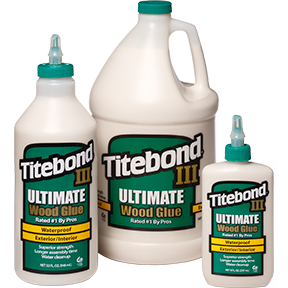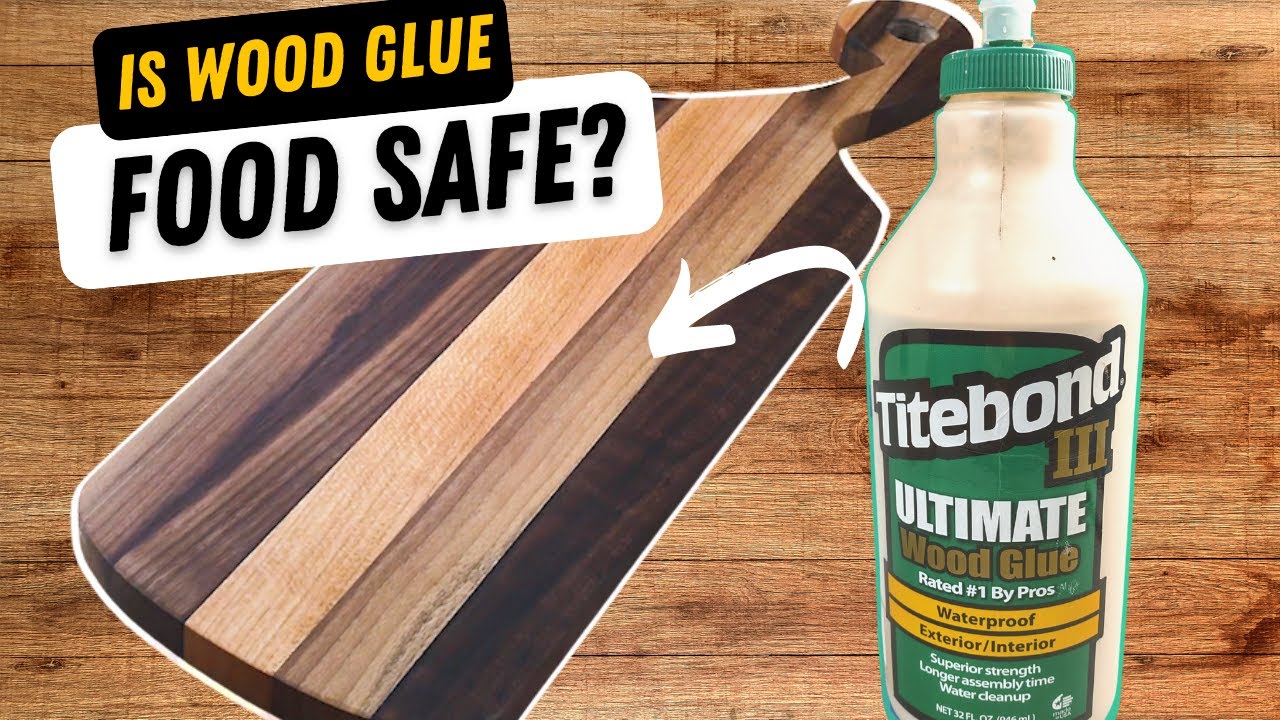If you’re wondering, “Is Titebond wood glue food safe?” you’ve come to the right place! Whether you’re a woodworking enthusiast or just curious about the safety of this popular wood glue, we’ve got all the answers you need. So, buckle up and let’s dive right in!
Now, I know what you’re thinking. “Is Titebond wood glue safe to use in food-related projects?” Well, my curious reader, you’re about to find out! We’ll explore the potential risks and benefits of using this adhesive in projects involving food contact.
But before we delve into the nitty-gritty details, let’s first understand what Titebond wood glue is and why it’s highly favored among woodworkers and DIYers worldwide. So, without further ado, let’s get started on this adhesive adventure!

Is Titebond Wood Glue Food Safe?
Wood glue is a common adhesive used in woodworking projects, but when it comes to using it on items related to food or food preparation, concerns about safety arise. In this article, we will delve into the topic of whether Titebond wood glue is food safe. We will explore the composition of Titebond wood glue, its potential risks, and its suitability for use in food-related applications. So, let’s dig in and find out if Titebond wood glue is safe to use around food.
#1. Composition of Titebond Wood Glue:
Titebond wood glue is a popular choice among woodworkers due to its strong bond and ease of use. To determine if it is food safe, we first need to understand its composition. Titebond wood glue is made primarily from a synthetic polymer emulsion called polyvinyl acetate (PVA). It also includes water, extenders, preservatives, and various other additives, depending on the specific product variant.
#2. Non-Toxicity and FDA Approval:
The question of whether Titebond wood glue is food safe is a valid one, especially when it comes to applications involving cutting boards or utensils that come into direct contact with food. Titebond provides a range of wood glues, such as Titebond III Ultimate Wood Glue, that are labeled as non-toxic and approved by the FDA for indirect food contact. However, it is essential to note that the FDA approval signifies suitability for indirect contact, meaning that the glue is not intended to be ingested or applied directly to food.
#3. Potential Risks and Precautions:
While Titebond wood glue is deemed safe for indirect food contact, it is crucial to take proper precautions to prevent any potential risks. For instance, when using Titebond wood glue in applications such as cutting boards or utensils, it is essential to let the glue fully cure and dry before bringing it into contact with food. This curing process typically takes 24 hours or more, depending on the environmental conditions.
Additionally, it is advisable to avoid using Titebond wood glue on surfaces that will be exposed to high heat, as this can cause the glue to break down, potentially releasing harmful substances. Also, keep in mind that Titebond offers specific variants like Titebond II Extend Wood Glue, which features water resistance and may be more suitable for projects involving exposure to moisture.
#4. Application Considerations:
When using Titebond wood glue in projects involving food contact, it is crucial to apply it correctly and allow sufficient drying time. Ensure that the surfaces to be glued are clean, dry, and free from any contaminants, as this can affect the adhesive’s performance. Apply a thin, even layer of glue to both surfaces, join them firmly, and clamp them securely until the glue dries completely.
Remember, Titebond wood glue is not waterproof or resistant to high temperatures, so it is essential to avoid submerging glued items in water or exposing them to excessive heat. Regular maintenance, such as occasional reapplication of food-safe finishes or sealants, can help ensure the longevity and safety of your projects involving Titebond wood glue.
#5. Alternative Food-Safe Glues:
If you have concerns about using Titebond wood glue for food-related applications, several food-safe alternatives are available in the market. Some examples include epoxy adhesives specifically designed for food contact, such as FDA-approved epoxy resin, or food-grade silicone adhesives that offer flexibility and water resistance. Remember to verify the product’s specifications and ensure it is explicitly labeled as food safe.
#6. Titebond in the Kitchen:
While Titebond wood glue may have its limitations when it comes to direct food contact, it can still find applications in the kitchen. Titebond offers a line of sealants and adhesives suitable for non-food-contact areas, such as sealing gaps around countertops or backsplashes. These products can help enhance the durability and aesthetics of your kitchen while maintaining food safety standards.
#7. Conclusion:
In conclusion, Titebond wood glue can be considered safe for indirect food contact when used correctly and allowed to cure fully. It is crucial to pay attention to the specific product variant, follow the manufacturer’s instructions, and take proper precautions to ensure food safety. However, if you require adhesive for applications involving direct food contact, it is advisable to explore alternative options explicitly labeled as food safe. Remember, the safety of food-related projects should always be the top priority, so choose your adhesives wisely and enjoy your woodworking creations with peace of mind.
Is Titebond Wood Glue Food Safe?
When it comes to using wood glue in food-related projects, it’s important to consider whether it is food safe. Here are some key takeaways to keep in mind:
- Titebond wood glue is not recommended for direct contact with food.
- The glue contains chemicals that may be harmful if ingested.
- Always use a food-safe adhesive for projects involving food or cookware.
- Look for wood glues that are specifically labeled as food safe.
- Test the adhesive on a small, inconspicuous area before using it on food-related projects.
Frequently Asked Questions
When it comes to woodworking projects, safety is always a top priority. Having concerns about the safety of the products we use is completely natural. Here are some frequently asked questions about the safety of Titebond wood glue for food-related projects.
1. Can I use Titebond wood glue on cutting boards or other food contact surfaces?
Yes, Titebond wood glue is safe to use on cutting boards and other food contact surfaces. It is FDA approved for indirect food contact and complies with all safety regulations. However, keep in mind that the glue should be fully dried and cured before it comes into contact with food. Follow the manufacturer’s instructions for the appropriate drying and curing time.
Additionally, it is important to note that Titebond wood glue is not intended to be ingested, so it should only be used on surfaces that do not come into direct contact with food. Always apply the glue to areas that will not be touched or consumed.
2. Is Titebond wood glue safe for bonding wooden utensils like spoons or spatulas?
Yes, Titebond wood glue is safe for bonding wooden utensils like spoons or spatulas. It is suitable for indirect food contact and does not contain any harmful substances that could leach into the food during use. However, it is crucial to ensure that the glue is fully dried and cured before using the utensil.
It is recommended to let the glue cure for at least 24 hours to ensure maximum strength and safety. After the curing period, the wooden utensil can be used with confidence, knowing that it has been securely bonded with a food-safe adhesive.
3. Can Titebond wood glue be used for repairing wooden cutting boards?
Yes, Titebond wood glue can be used for repairing wooden cutting boards. It provides a strong bond that helps restore the integrity of the cutting board. However, before applying the glue, it is essential to thoroughly clean and dry the surface of the cutting board. Remove any food particles, grease, or oils that may hinder proper adhesion.
Apply a thin layer of Titebond wood glue to the surfaces to be bonded, and then clamp the pieces together firmly. Let the glue cure for the recommended time, typically 24 hours, before using the cutting board again. Following these steps will ensure a safe and sturdy repair for your cutting board.
4. Is Titebond wood glue waterproof and food safe?
No, Titebond wood glue is not waterproof or recommended for use in applications where it will be consistently exposed to water. While it provides a strong bond, it is not designed to withstand prolonged exposure to moisture. Therefore, it is essential to keep wooden items bonded with Titebond wood glue away from water sources when possible.
As for the food safety aspect, Titebond wood glue is safe for indirect food contact when it is fully cured. However, it should not be ingested directly. Always exercise caution and use Titebond wood glue in a manner that complies with its intended purposes and safety guidelines.
5. Can Titebond wood glue be used for assembling wooden kitchen cabinets?
Yes, Titebond wood glue is an excellent choice for assembling wooden kitchen cabinets. It provides a strong bond and ensures long-lasting durability for your cabinets. Before applying the glue, make sure the surfaces are clean, dry, and free from dust or debris.
Apply a thin layer of Titebond wood glue to one of the surfaces and then firmly press the two pieces together. Use clamps to hold the pieces in place during the curing process, which typically takes 24 hours. After the glue has fully cured, your kitchen cabinets will be securely assembled and ready for use.

Summary
Titebond wood glue is not considered food-safe and should not be used on items that come into contact with food. While it is non-toxic when dry, it is not meant for ingestion.
When working on projects involving food, it is best to use adhesives specifically labeled as food-safe. These glues are specially formulated to be safe for contact with food and are your best bet for peace of mind.
